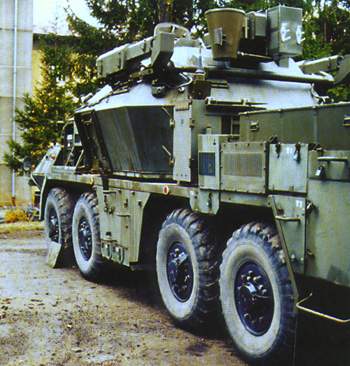T
Turko
Guest
30mm STROP SPAAG

CZK - STROP II : Ostatní - zatím nezařazeno
The Moguce [Power] STROP 2 self-propelled anti-aircraft prototype, based on the Tatra T-815 chassis (same for Dana howitzer), was a Czechoslovak anti-aircraft weapon. The combination of the advantages of anti-aircraft cannon and missile placed it in the category of so-called hybrid sets. The set was developed since 1987 and completed in 1996 by the Research and Testing Institute of the Army of the Czech Republic in Vyškov. It was not introduced into service and remained only in the prototype stage.
A small-caliber automatic 30mm double-barreled cannon 2A38 cooled by water together with anti-aircraft missiles 9M 313 IGLA (SA-16) and a unified control system. The effective range of the cannon is 3 km, PLRS 5 km. The set has exclusively passive systems for detecting and tracking air targets. The control system consists of: a laser rangefinder, a television sight, a passive radar protractor system and a computer system. The total weight of the set is 27 t, the crew is three members.
In the early 1980s the Czechoslovak People's Army was armed with obsolete self-propelled anti-aircraft double cannons. It therefore launched the Promet program, on which it wanted to cooperate with Poland, which resulted in a new self-propelled anti-aircraft cannon for the protection of ground troops. Due to the political instability of Poland, the Czechoslovak Socialist Republic decided to develop a new weapon independently under the new name STROP [CEILING]. The modernization of the Lizard or the development of a system with a new cannon of domestic origin was considered, but later the Soviet 30mm double-barreled weapon 2A38 was preferred.
A key element of the set was to be a new fire control system, consisting of PRUS I and II devices (passive radar protractor system) and optical components (included laser rangefinder, television camera and optical sight). Testing of these devices was to take place on a test specimen called STROP I, which used a chassis from a tracked infantry fighting vehicle BVP-1 and the weapon part of the Lizard (including a pair of its 30mm cannons). This device was made in 1982 and was followed by tests of the fire control system.
The tests turned out well, so the development of the serial form, called STROP II, was approved. The main researchers were military research institutes from Slavicín, Prague and Brno, but later the whole solution was transferred to Konstruktta Trencín. In addition, Tesla companies from Pardubice, Kolín and Orava, as well as Meopta from Prerov and others, among which the Koprivnice Tatra played a special role, also took part in the project. The standard version, the development of which began in early 1986, was to use a powerful eight-wheeled chassis T815 taken from the 152mm self-propelled howitzer vz.77 DANA. On the one hand, this promised to simplify logistics in the service, but during the development it also brought problems, especially concerning the mechanisms for fast and accurate movement of a heavy and large turret.
The prototype of the vehicle was produced only after 1989. After the division of Czechoslovakia, Slovakia o continued development, which modified the STROP II to a version called BRAMS, which had a different fire control system and instead of Strela-2M missiles received four more modern Igla missiles. The development of this machine was successfully completed, but the Slovak army did not order it. The STYX design was created in the Czech Republic, which also included a Tatra chassis, but it was to carry a Swiss turret with a 35mm Oerlikon cannon. However, STYX did not exceed the model stage.
In the large tower was placed as the main armament of STROP II Soviet 30mm cannon 2A38 (its most famous application is the assembly of two pieces of anti-aircraft 9K22 Tunguska) with a cadence of up to 2400 rounds per minute; there were 1,300 rounds available in five boxes of 260, two of which were ready for immediate use. Cannon had an effective range of up to 4000 m. The addition was also PKT 7.62 mm gun at a rate of fire up to 800 rounds per minute and a supply of 2,000 rounds. The tower was also a pair of light (originally portable) 9K32 Strela-2M anti-aircraft missiles with thermal guidance and a range of 4200 m.
The prototype has been preserved and can be viewed in the exposition of the Military Technical Museum in Lešany.
